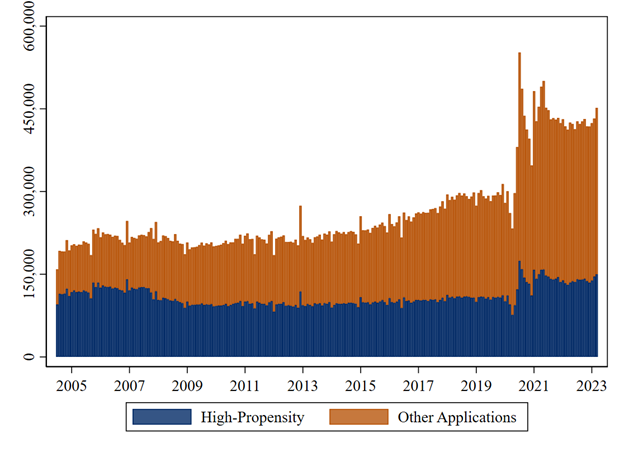Investing in America Means Investing in America’s Small Businesses
Small businesses are an essential part of the American economy, and core to the financial security of our middle class. There are 56 million workers employed at firms with fewer than 50 employees, representing 45 percent of all private-sector jobs in the first quarter of 2022.[1] Young firms, which often start small with few employees, are a driving force in job creation. Moreover, closing the gap in small business ownership rates between Black and white households could narrow the gap in average net worth between these groups by up to $185,900 (22 percent), while closing the gap in ownership between Hispanic/Latino and white households could reduce these groups’ gap in net worth by $138,800 (17 percent). Together, these dynamics have made supporting small businesses a priority for the Biden Administration.
Recent strength in small business applications
During the pandemic, there was considerable concern about the potentially disproportionate effects COVID-19 would have on small businesses. However, data show that small business growth has proved resilient, supported by effective and equitable implementation of the American Rescue Plan (ARP). 2021 saw the largest growth in new jobs among businesses with fewer than 50 employees on record, with over 3 million new jobs created across the country. The past two years have seen the two highest years of business applications on record (figure 1), as Americans applied to start nearly 10.5 million small businesses.

Source: U.S. Census Business Formation Statistics and CEA calculations.
Note: Business applications refer to applications for an Employer Identification Number (EIN). High-propensity applications are those deemed likely to turn into a business with payroll.
As the economy transitions to stable, steady growth, new business formation and job creation will likely begin to slow from this exceptionally fast pace. While business applications remain elevated, the pace of job growth among small businesses slowed in 2022, compared to 2021.
Invest in America and small businesses
Recent laws core to the President’s Investing in America economic agenda—including the ARP, the Bipartisan Infrastructure Law (BIL), the CHIPS and Science Act (CHIPS), and the Inflation Reduction Act—can directly and indirectly provide opportunities for small and young firms. Indeed, written directly into the laws are a host of features designed explicitly to support small business. For example, the Inflation Reduction Act doubled the existing Research and Development tax credit for small businesses, and the CHIPS funding opportunity will partially evaluate applicants based on how they plan to create opportunities for minority-owned, veteran-owned, women-owned, and small businesses to participate in construction or the supply chain.
On top of specific small business provisions, perhaps some of the greatest benefits to small and young businesses will come indirectly. This includes the expansion of infrastructure and spillover effects of the investment in new and critically important industries. Consider, for example, the $65 billion in spending in the Bipartisan Infrastructure Law to close the digital divide by expanding access to broadband. Several recent papers have found causal links between expansions of broadband access and the creation of new businesses, as well as the growth of existing businesses, in urban and near-urban areas. While the evidence for the causal links between rural broadband access and the formation and growth of businesses is not as robust, the literature indicates that rural broadband expansion also likely affects business growth and formation, particularly in knowledge-intensive industries.
Another indirect benefit will come as larger firms receive investments, which can provide spillover benefits for smaller businesses. The literature on agglomeration indicates that investments in large firms can benefit smaller businesses in their area via increased demand for local goods and services and increased productivity. One estimate found that adding one high-skilled manufacturing job in an urban area creates 2.5 jobs in the city’s non-tradable sector—jobs in construction, food service, or any other role that provides a good or service that cannot be traded over distances. This multiplier effect could make for significant additional job growth due to the increase in manufacturing investments in the months since the legislation was signed into law.
Some research has also shown that there are positive spillovers—in the form of higher productivity—to local firms that share the same labor pool or set of technologies as the “anchor firm” (the large firm arriving in a given area). For example, one estimate found that incumbent firms experience a 12 percent productivity increase after a new plant arrives in a county. The literature on spillover effects on jobs within the supply chain is more complex, as existing firms shed workers, who then go on to form new firms of their own. This leads to a surge in new firms, but not a net increase of employment.
Together, this legislation has the potential to help support continued small business formation and job creation—benefitting communities and small business owners across the country—even as the economy continues to recover from the pandemic. These benefits will likely be further enhanced by the crowding in of private investment given the early indications that private investment has already begun to respond to the legislation.
[1] This only includes jobs covered by the Unemployment Insurance system, the actual number is likely higher. Data are from Quarterly Census of Employment and Wages.

